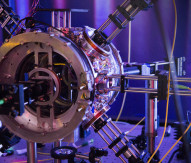
‘Cubesats’ to explore thermosphere
An EU-led project named QB50 will see 50 small satellites released from the International Space Station (ISS) to begin investigating the Earth’s thermosphere.
The satellites, known as cubesats and weighing an average of 2kg each, have been built by 48 universities in 28 countries around the world, including France, Italy, Belgium and the UK. The cubesats will include multiple scientific instruments for investigating the earth’s atmosphere including an ion/neutral mass spectrometer, a flux probe experiment and a multi-needle Langmuir probe.
The thermosphere, which is between 200 and 380km above the surface, is vital for communications and shields the Earth from cosmic rays, but is not well understood by contemporary science. Andrew Dempster, director of the Australian Centre for Space Engineering Research which also contributed cubesats to the project, explained the need to research the thermosphere: “This region is poorly understood and hard to measure. And yet, it’s the interface between our planet and space. It’s where much of the ultraviolet and X-ray radiation from the Sun collides with the Earth, and generates auroras and potential hazards that can affect power grids and communications.”
The project will be launched to the ISS in December, with the cubesats themselves entering orbit in January. The project marks the most thorough and technologically advanced exploration of the thermosphere ever undertaken, and hopes to be in operation for between three and nine months, depending on the durability of the satellites.
More information on the project can be found here: https://www.qb50.eu/




